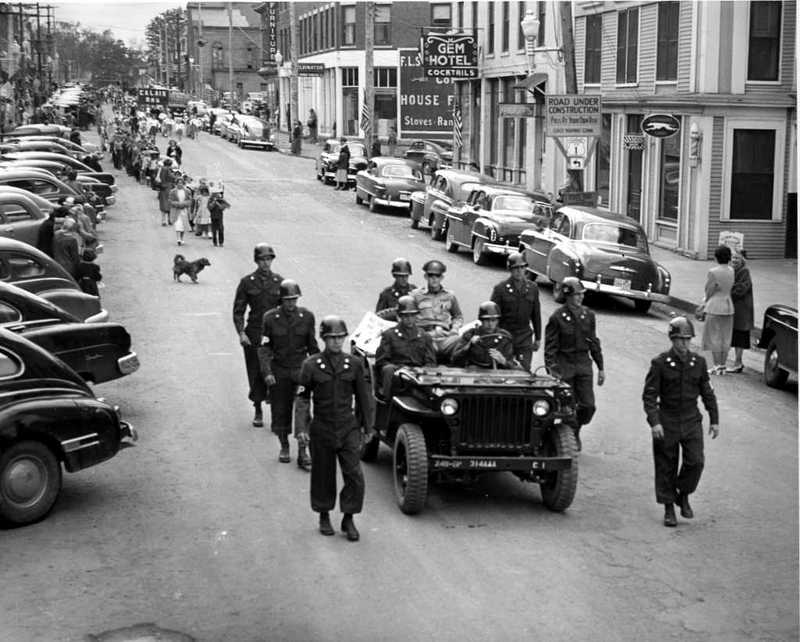
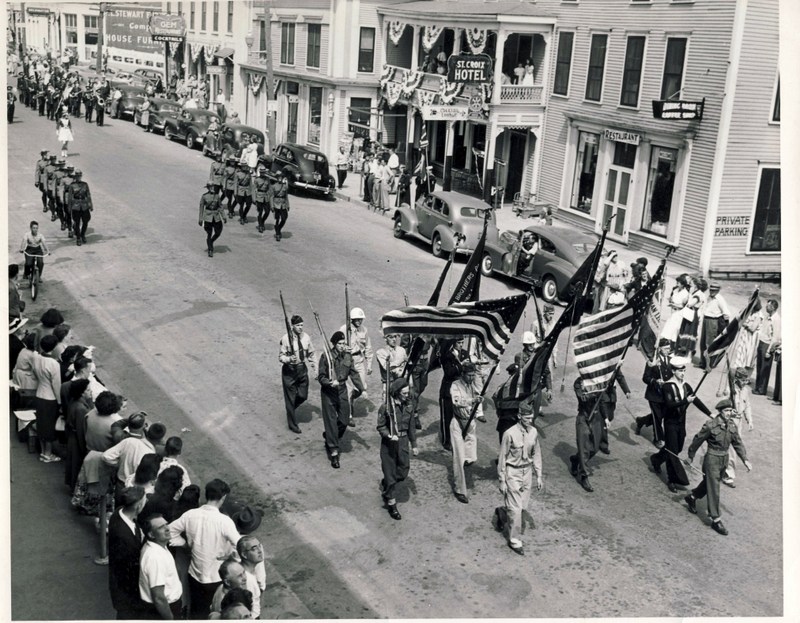
Many will recognize the street scenes in the 1950s photos above, a parade on Main Street passing the St. Croix Hotel. In the first photo Floyd McGlinchey is the jeep’s driver, Donnie Phelps is the passenger, and in the rear seat, doing his best General Douglas MacArthur imitation, is Jimmy Carpenter. Bruce Sherlock, Norman Noddin, Jim McClure, Mickey MacFarland and Phil Poole march beside the jeep which has just passed a long forgotten but venerable old Calais hostelry—the Gem Hotel and Restaurant. The Gem’s sign can be seen in the top right of the first photo and top left of the second. Venerable may be overstating the Gem’s reputation a bit—its nickname at one time was the “Germ” but we suspect this was merely a malicious attempt by a competitor to smear a rival. We thought it would be interesting to bring the Gem back to life, if only briefly, with some old photos.
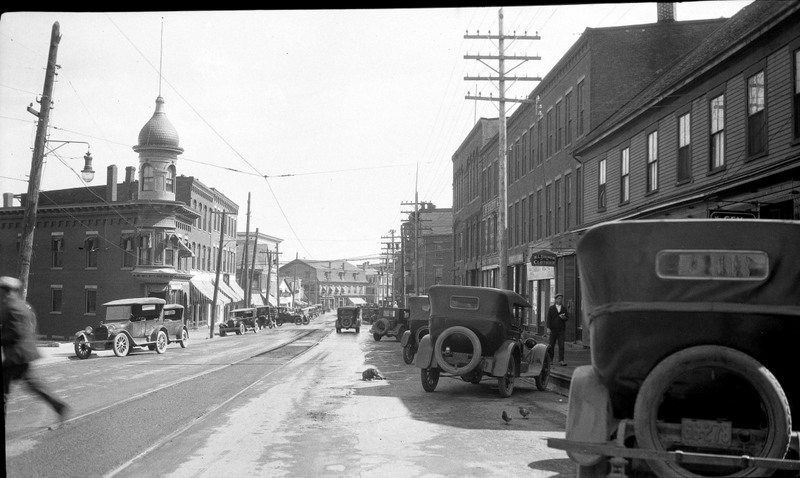
The Gem Restaurant was not originally located next to the St. Croix Hotel but up Main Street across from the Post Office. In the circa 1920 photo above, the top of the “Gem” sign can be seen above the roof of the auto on the far right.
To the left is the distinctive Kalish minaret which sat atop what was to become the Calais Federal Savings and Loan in the 1930s. To the right is the Beckett Block and corner of North Street. We have no idea who owned the dog but like to think its owner was having lunch at the Gem.
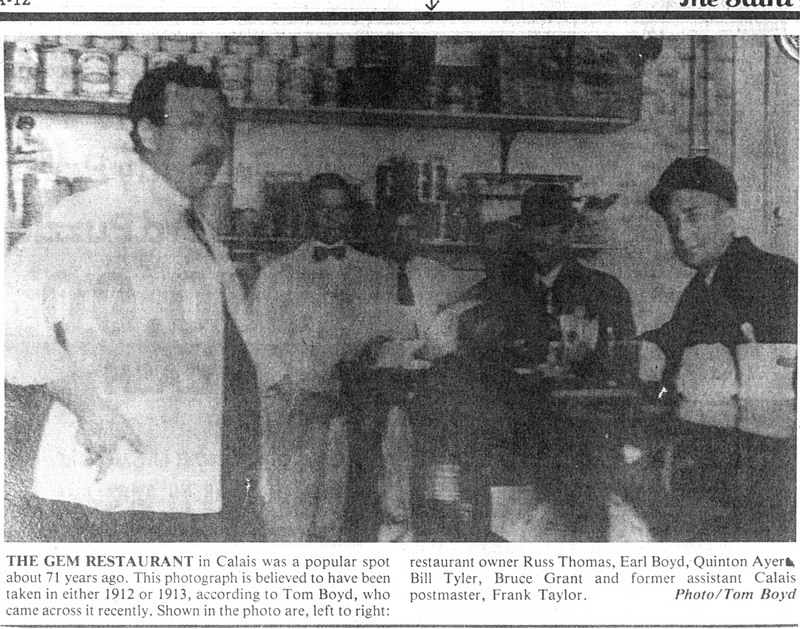
The grainy photo above was published in the St. Croix Courier in the 1980s. According to Frank Beckett, James Russell Thomas, far left, started the business in about 1910. He was, we believe, the great-grandfather of Ken Thomas, the owner of the International Hotel. According to Frank, “Russ” as he was called, had already been successful in the restaurant business before opening the Gem and was known locally to “serve good food.”
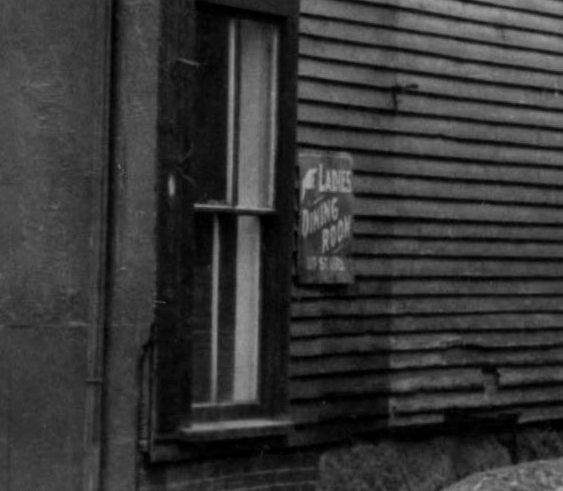
A narrow alley led off Main Street from the Gem and at the entrance to the alley a sign advertised “Ladies Dining Room Down The Alley,” so it is possible the Gem had a separate dining area for ladies. This was all the rage back in those days—not because men refused to dine with women but because women much preferred to dine without men.
Earl Boyd, standing beside Russ in the photo, worked at the Gem until the Great War took him to the Western Front in France. He wrote his mother a very touching letter from the front which ended as follows:
“I am writing this letter in the YMCA and it is closing up but there is one thing more I must say to you, please do not worry about me, for I will be all right. Of course, dear mother, we cannot all go back to America but every mother prays that her son can come back and perhaps I will be one of the boys to go back.”
Perhaps his mother would have been more reassured had he stopped writing after “I will be all right” but Earl correctly foretold the future, he did return after a rough tour of duty; but two Calais boys in his company, the Sherman brothers, died in combat probably before this letter reached Mrs. Boyd.
Quinton Ayer was likely Russ’s cook. He was Glendon Ayer’s father and had a reputation locally as a chef, working for many years in Calais restaurants and in Maine Central Railroad dining cars.
We don’t know what became of Bruce Grant; and Bill Tyler is mentioned only once in our archives although in connection with a notable historical fire in the city.
At the time the Calais and St. Stephen fire departments were fighting a losing battle with a spectacular and deadly blaze that destroyed the Pettigrove Hotel off Tyler Street in Calais. It was during this fire that the famous Calais raconteur and bookseller O.P. Treat, then a guest, managed to find himself straddling the hotel’s sign “being flurried, instead of walking down the stairs, O.P. crawled out of the window at the top of the porch and then crawled out onto the sign where he sat in the bitter cold dressed in red flannel underwear, a silk hat and a pair of carpet slippers.”
Although the building was consumed by fire, the firemen were finally able to rescue Treat who thanked them kindly and walked off down Main Street in his silk hat and carpet slippers to spend the rest of the night at his bookstore. He was lucky, three charred bodies were found in the ashes of the hotel the next day.
Frank Taylor, on the far right, graduated from Calais Academy in 1895 and was a pretty fair baseball player. He became assistant postmaster. We know little more about him other than his being the judge of the potato race competition at the 1894 Fourth of July celebration. If anyone develops a Calais Trivial Pursuit game this may be an important fact to remember.
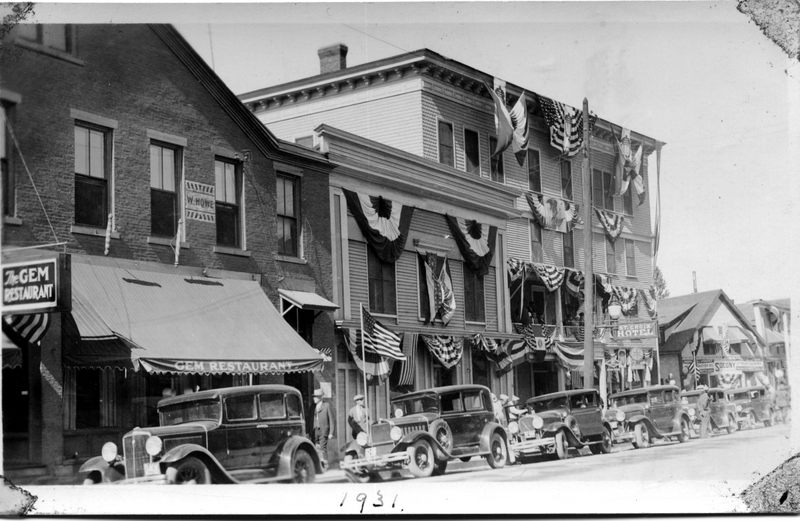
We can’t be sure when the Gem moved up Main street to the building adjacent to the St. Croix Hotel but it was probably in the late 1920s. To be honest we can’t even be sure there was any continuity in ownership. We do know that Mae Bovard, who graduated from Calais Academy in 1920, was the Gem’s owner by the early ‘30s, and after the move the business became the Gem Restaurant and Hotel. The restaurant had its heyday during World War 2.
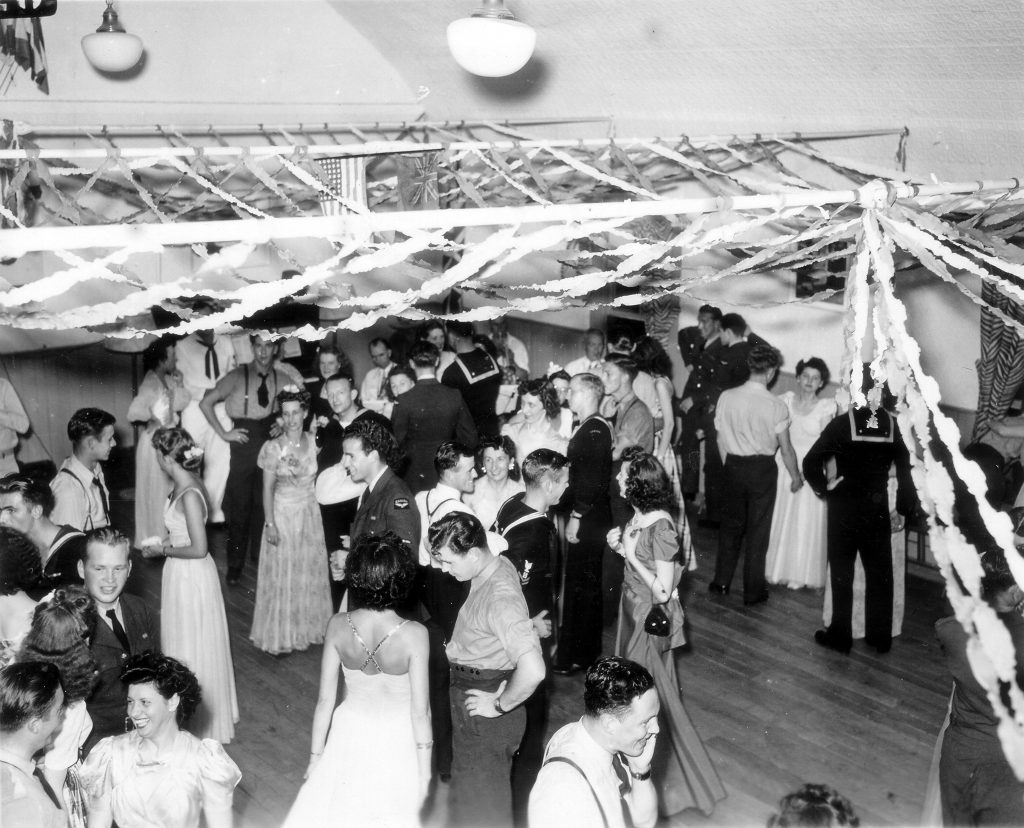
Many people remember the Gem from the late ‘30s and the war years when romance was apparently always on the menu. Eugenia Townsend’s mother, Anne Carter Townsend, worked at the Gem from 1937-39. Her future husband Norman, an employee at the Merrill Bank, began coming in daily. He found attractions in the Gem other than its cheeseburgers, a Gem specialty. Dolph Lentz met his wife Winifred at the Gem during his first military leave in 1944. They married the next year, a marriage that lasted until Winifred passed away 59 years later.
During the war the Gem was a favorite hangout of the Seabees from Quoddy Village, airmen from St. Stephen, and anyone else wearing a uniform. It was on the regular circuit of dance halls, clubs and cafés that catered to servicemen on leave in Calais which may explain the comment by one person that “it was quite a drinking place” although we think it unlikely it was any worse than its competitors. Busloads of Calais girls went to dances in Quoddy Village and the Seabees came to Calais by the hundreds to dance at the USO on Lowell Street which in later years became the VFW and American Legion Halls. The photo above shows a USO dance at Lowell Street. Some may recognize the smiling woman in the lower left-hand corner of the photo—Jessie Baig.
Grace Meader has a nice memory of the Gem. She was a friend of Leta Matthews who lived in Milltown in an apartment over Clark’s store during the war. Leta was going out with Bob Gillis who was in the military. One day Grace and Leta were walking down Main Street when Leo Phelan, the mailman, called to Leta “Hey Leta, I’ve got a package for you” and handed Leta a package from Bob. They went into the Gem where Leta opened the package and found it contained an engagement ring. They were married within the year.
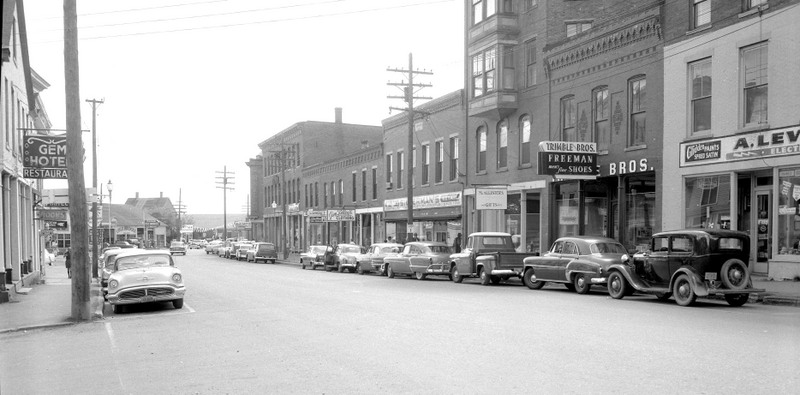
In later years Mae Bovard’s daughter, Berla DeCosta, took over management of the Gem. Teresa Kelly MacLean’s mother, Margaret Kelly, worked there in the early ‘50s as a waitress, as did her aunt Mary Kelly (as a cook) and several other family members. By then the Gem was owned by Berla and her boyfriend Piper Lynch. Laura Nixon and Grace Cottrell were also cooks. Teresa recalls washing dishes at the Gem a few times. She was very young and had to stand on a stool to do the dishes. She and her friends often went to the Gem for cheeseburgers, fries and Coke.
There is some suggestion Piper Lynch and his cronies turned the Gem into a gambling den which was somewhat dangerous as the police frequented the establishment in the line of duty. In those days the police didn’t have a police car but walked the beat along Main Street. A blue light was affixed to the telephone pole next to the Gem which was turned on to alert the beat cop if there was trouble. If the officer couldn’t hail a taxi to be taken to the scene of the crime, he needed to call one from the nearest phone which, of course, was in the Gem.
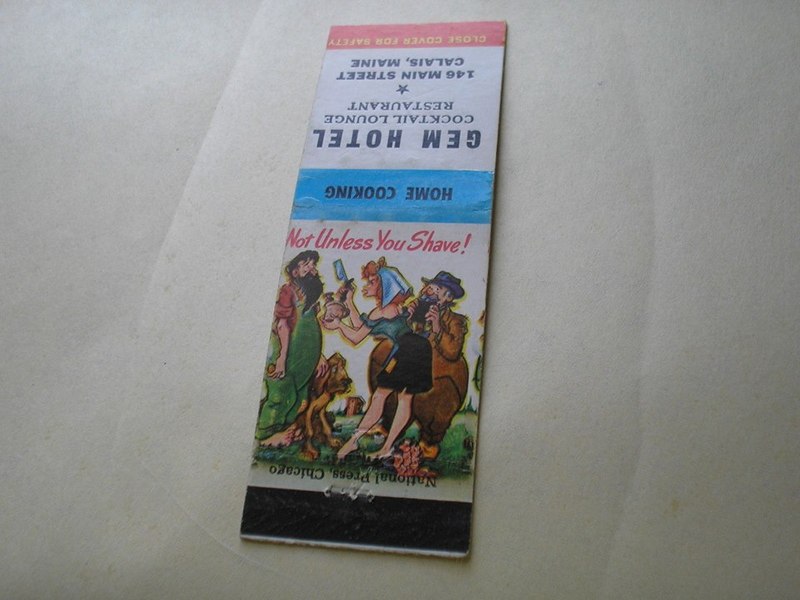
By the late ‘50s the Gem’s days were numbered although the restaurant was still listed in a Chamber of Commerce brochure in 1954 under “Where to Eat in Calais,” and the 1957 phone book tells us the Gem Hotel, Inc. could be reached by asking the operator to be connected to 395. The hotel is not listed in the 1954 brochure as a place to stay in Calais. Above is a matchbook advertising the Gem from that era, and you can make what you will of the message the Gem intended to convey. We will say that many businesses of this era provided their customers explicit and what would today be considered objectionable and politically incorrect promotional material such as the complimentary matches shown above. These matches were tame compared to the calendars displayed in garages, shops and some stores in those days. It would probably be a federal offense today to send some of those through the mail.
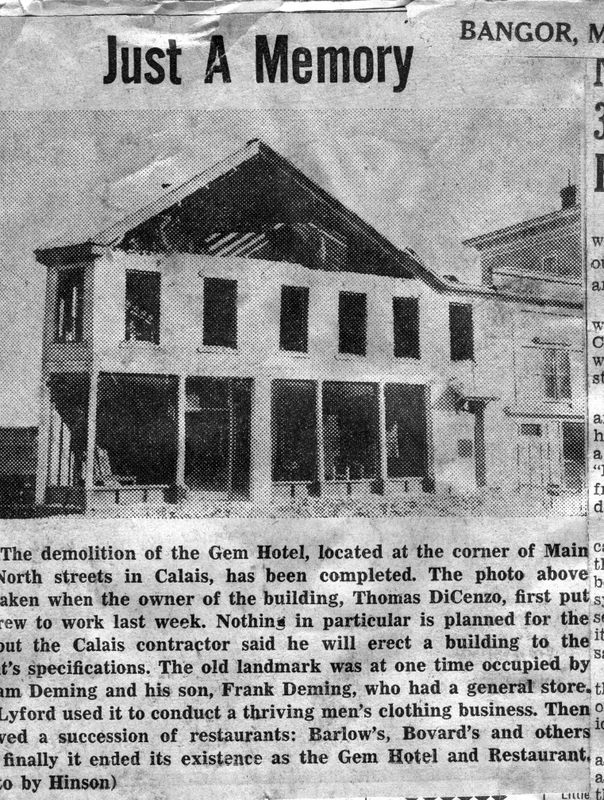
The Gem was no longer in the phone book in 1958 and the above clipping from the Advertiser explains why telephone number 395 was no longer connected. The Gem was demolished on March 5, 1958.
